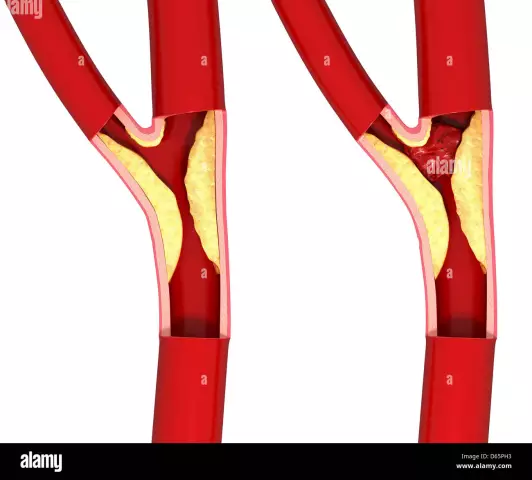- Author Rachel Wainwright [email protected].
- Public 2023-12-15 07:39.
- Last modified 2025-11-02 20:14.
Abdominal aorta
Abdominal aorta. general characteristics

The abdominal aorta is an extension of the thoracic aorta. It is located at the level of the anterior surface of the lumbar vertebrae, on the left side of the midline. The abdominal aorta begins at the XII vertebra and reaches the IV-V lumbar vertebrae, after which it branches, forming two iliac arteries. In this case, the unpaired median sacral artery departs from the site of division in the direction of the small pelvis.
In addition, the aorta has branches that are known as the parietal and visceral branches of the abdominal aorta.
Branches of the abdominal aorta
Many branches of the aorta allow it to supply blood to the organs closest to it. The branches are divided into groups. The parietal branches include the following:
- Inferior phrenic artery. It is a large paired vessel responsible for the blood supply to the lower surface of the diaphragm and adrenal glands;
- The lumbar arteries, which are 2 pairs of large vessels. They supply blood to the muscles of the abdomen, back, as well as the skin, fiber and spinal cord.
The internal vessels of the aorta include both paired groups of branches and unpaired ones. Paired arteries are described below:
- Middle adrenal. Provides blood to the adrenal gland;
- Renal. Located on the back of the inferior vena cava. Approaching the gate of the kidney, it gives a branch in the form of the inferior adrenal artery that feeds the adrenal gland.
The unpaired visceral branches of the abdominal aorta are as follows:
- The celiac trunk, which is a vessel 1-2 cm long, departs from the aorta around the XII vertebra. It is divided into three other arteries: a) the left pancreas, which supplies blood to the body of the stomach, and also gives 12 branches feeding the esophagus; b) the common hepatic, consisting of two arteries (actually the hepatic, supplying blood to the gallbladder and liver and gastroduodenal, which feeds the pancreas, duodenum and (through the gastroepiploic branch) the walls of the stomach and the greater omentum itself); c) splenic, feeding the spleen, the wall of the stomach, partly the pancreas;
- Superior mesenteric. It originates in the region of the II lumbar vertebra, passes along the anterior surface of the duodenum, then divides into several branches near the iliac fossa. The branches, in turn, feed the pancreas, the jejunum, the blind, the colon, and the ileum;
- Inferior mesenteric. This artery originates in region III of the lumbar vertebra and gives rise to several branches that supply blood to the colon and rectum.
Diseases of the abdominal aorta

The most common diseases affecting the abdominal aorta are those described below:
1. Atherosclerosis of the abdominal aorta. The cavity of the vessel affected by this disease is covered with lipoproteins, which slow down the blood flow. In the future, the proliferation of connective tissue is possible, which is replaced by atherosclerotic plaques. Symptoms of atherosclerosis of the abdominal aorta include paroxysmal abdominal pain, flatulence, bloating, and constipation. The pain can last up to 3 hours (in severe cases). Most often, their intensity decreases when taking antispasmodic drugs, but subsequently diarrhea may appear, the frequency of which reaches 3 times a day. In this case, undigested food debris can often be found in the feces. In mild cases of atherosclerosis of the abdominal aorta, attacks are limited to vague pain in the abdomen or right hypochondrium, belching and constipation;
2. An aneurysm of the abdominal aorta is an enlargement of the vessel in that part of it where the wall is most weakened. In this case, the abdominal aorta is considered the most vulnerable vessel, because up to three quarters of all diseases of this nature occur in the abdominal aorta. Lack of timely treatment can lead to rupture of the abdominal aorta and bleeding, including fatal. Another danger with aneurysm is the development of a blood clot, which is associated with a violation of blood flow in the affected vessel. That is why it is important to pay attention to the early symptoms of the disease in time: the appearance of a pulsating formation in the abdominal cavity, the occurrence of severe pain in the lower back, vomiting, and in some cases, a change in the color of urine and pale extremities. The most susceptible to the appearance of aneurysm in general and rupture of the abdominal aorta in particular are patients with arterial hypertension, inflammatory processes of the aortic walls, with congenital diseases of the connective tissue, as well as those affected by infectious diseases that cause damage to the walls of blood vessels. There is a high risk of developing atherosclerosis in persons over 60 years of age, in smoking patients, and in patients with high blood pressure.
Found a mistake in the text? Select it and press Ctrl + Enter.






